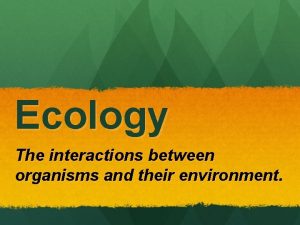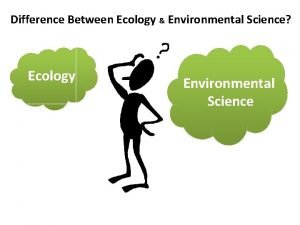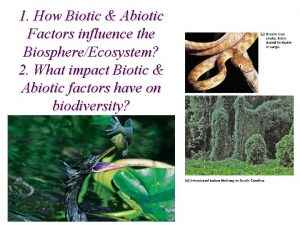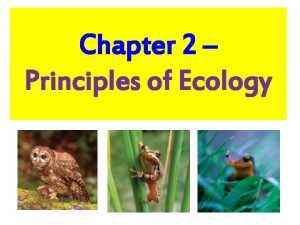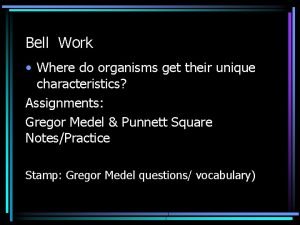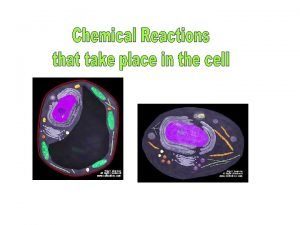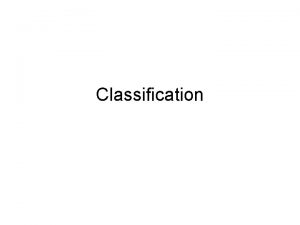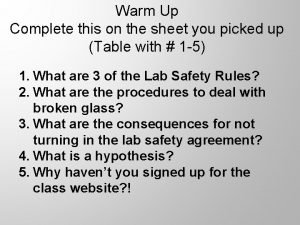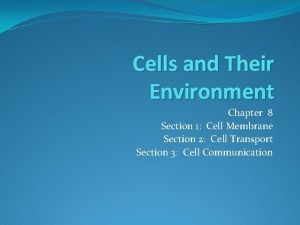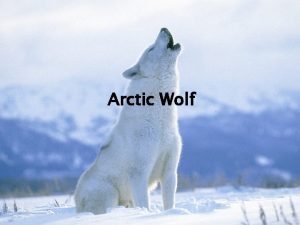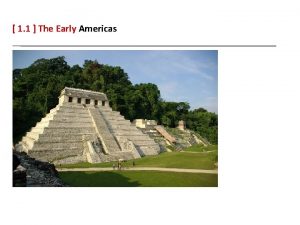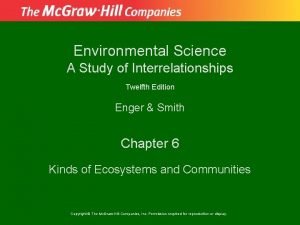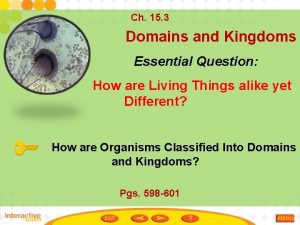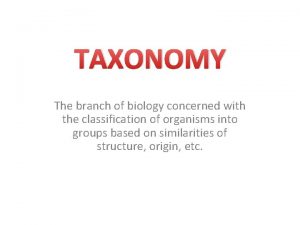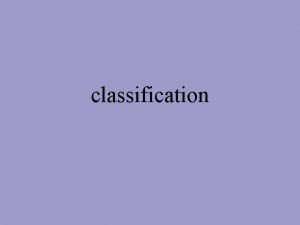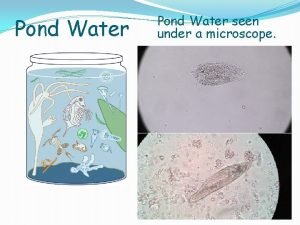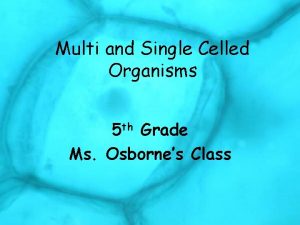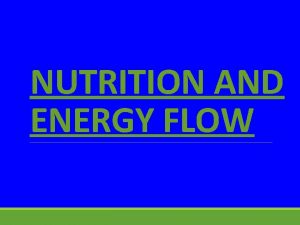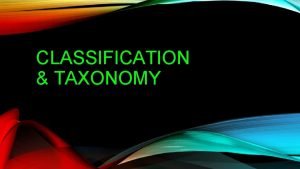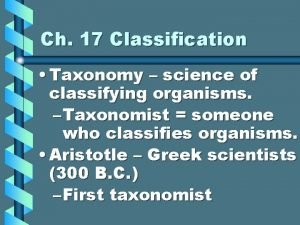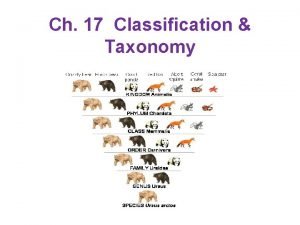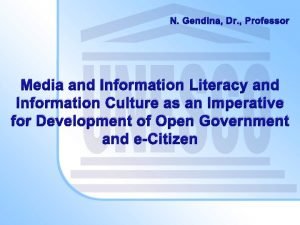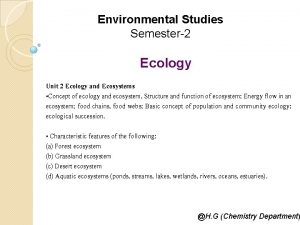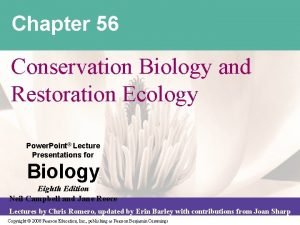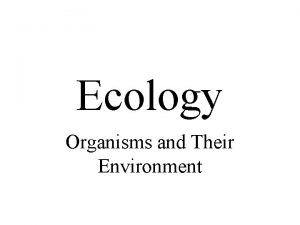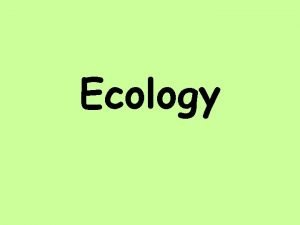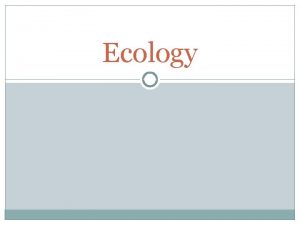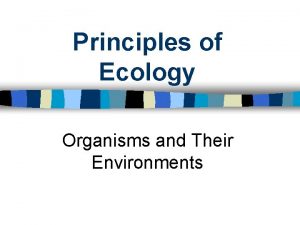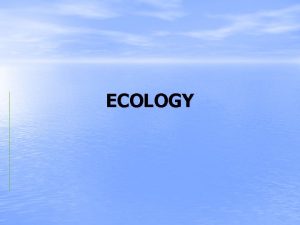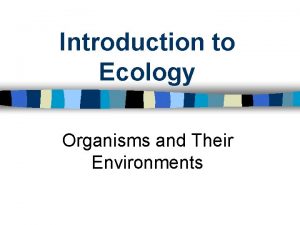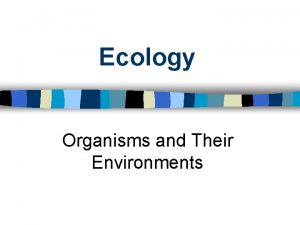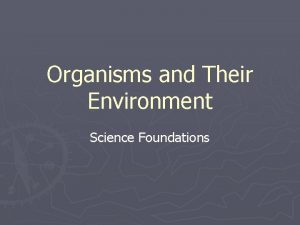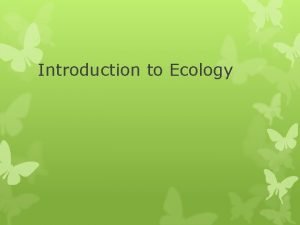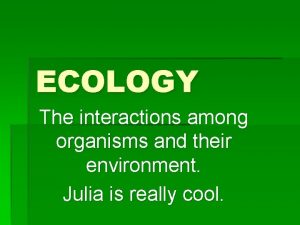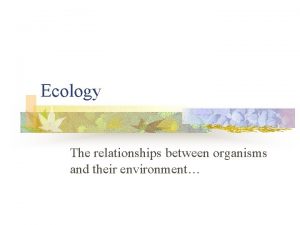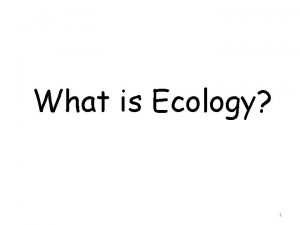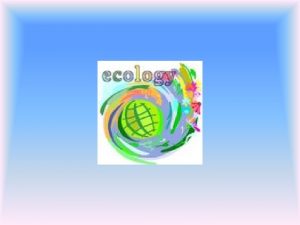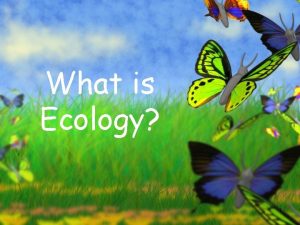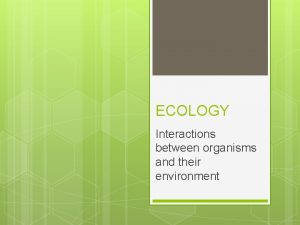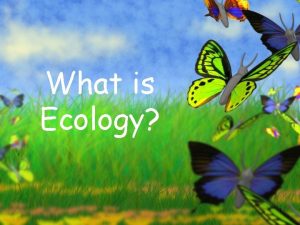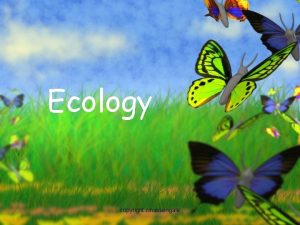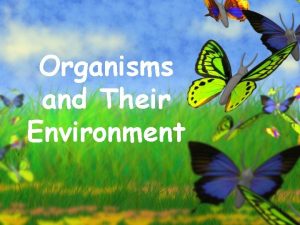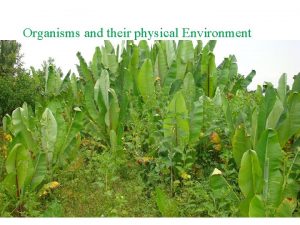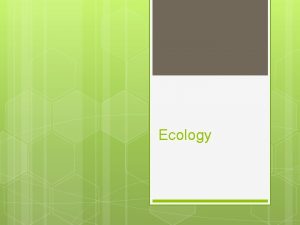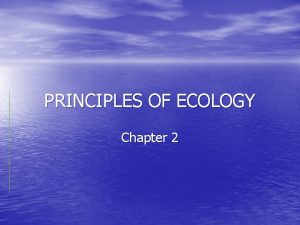Ecology Organisms and Their Environment What is Ecology














































- Slides: 46

Ecology Organisms and Their Environment

What is Ecology • The study of interactions that take place between organisms and their environment. • It explains how living organisms affect each other and the world they live in.

Habitat & Niche • Habitat is the place a plant or animal lives • Niche is an organism’s total way of life

The Nonliving Environment • Abiotic factors- the nonliving parts of an organism’s environment. • Examples include air currents, temperature, moisture, light, and soil. • Abiotic factors affect an organism’s life. 4

The Living Environment • Biotic factors- all the living organisms that inhabit an environment. • All organisms depend on others directly or indirectly for food, shelter, reproduction, or protection. 5

Abiotic or Biotic?

Biosphere Levels of Organization Biome Ecosystem Community Population Individual

1 st Level of Organization • Organism: An individual living that is made of cells, uses energy, reproduces, responds, grows, and develops 8

2 nd Level of Organization • Population: A group of organisms, all of the same species, which interbreed and live in the same place at the same time. 9

3 rd Level of Organization • Biological Community: All the populations of different species that live in the same place at the same time. 10

4 th Level of Organization • Ecosystem: Populations of plants and animals that interact with each other in a given area with the abiotic components of that area. (terrestrial or aquatic) 11

5 th Level of Organization • Biosphere: The portion of Earth that supports life. 12

The Biosphere • Life is found in air, on land, and in fresh and salt water. • The BIOSPHERE is the portion of Earth that supports living things. 13

Producers • Sunlight is the main energy source for life on Earth. • Only plants, some algae, and certain bacteria can capture energy from sunlight or chemicals and use that energy to produce food. • These organisms are called autotrophs. • Because they make their own food, autotrophs are called producers.

• During photosynthesis, these autotrophs use light energy to convert carbon dioxide and water into oxygen and energy-rich carbohydrates. Consumers • Organisms that rely on other organisms for their energy and food supply are called heterotrophs. • Heterotrophs are also called consumers.

Energy Flow • Energy flows through an ecosystem in one direction, from the sun or inorganic compounds to autotrophs (producers) and then to various heterotrophs (consumers). • A food chain is a series of steps in which organisms transfer energy by eating and being eaten.

Feeding Relationships In some marine food chains, the producers are microscopic algae and the top carnivore is four steps removed from the producer. Zooplankton Small Fish Squid Algae Shark

Feeding Relationships Food Webs • Ecologists describe a feeding relationship in an ecosystem that forms a network of complex interactions as a food web. • A food web links all the food chains in an ecosystem together.

Ecological Pyramids Energy Pyramid: Shows the relative amount of energy available at each trophic level. Only part of the energy that is stored in one trophic level is passed on to the next level. 0. 1% Third-level consumers 1% Second-level consumers 10% First-level consumers 100% Producers

All living things require water to survive. Water moves between the ocean, atmosphere, and land. The Water Cycle Copyright Pearson Prentice Hall

Carbon Cycle CO 2 in Atmosphere Photosynthesis feeding Volcanic activity Respiration Decomposition Human activity Erosion CO 2 in Ocean Respiration Uplift Deposition Photosynthesis Fossil fuel feeding Deposition Carbonate Rocks

The Nitrogen Cycle All organisms require nitrogen to make proteins. Although nitrogen gas is the most abundant form of nitrogen on Earth, only certain types of bacteria can use this form directly. Such bacteria live in the soil and on the roots of plants called legumes. They convert nitrogen gas into ammonia in a process known as nitrogen fixation.

Nitrogen Cycle N 2 in Atmosphere Synthetic fertilizer manufacturer Uptake by producers Bacterial nitrogen fixation Decomposition Reuse by consumers Decomposition excretion NH 3 Atmospheric nitrogen fixation Uptake by producers NO 3 and NO 2 Decomposition excretion Reuse by consumers

Nutrient Cycles Other soil bacteria convert nitrates into nitrogen gas in a process called denitrification. This process releases nitrogen into the atmosphere once again.

Community Interactions • Competition occurs when organisms of the same or different species attempt to use an ecological resource in the same place at the same time. • A resource is any necessity of life, such as water, nutrients, light, food, or space. • An interaction in which one organism captures and feeds on another organism is called predation. The organism that does the killing and eating is called the predator, and the food organism is the prey.

Symbiosis • Any relationship in which two species live closely together is called symbiosis. Symbiotic relationships include: – mutualism – commensalism – Parasitism Mutualism: both species benefit from the relationship. Commensalism: one member of the association benefits and the other is neither helped nor harmed. Parasitism: one organism lives on or inside another organism and harms it.


Ecological Succession Gradual change in living communities that follows a disturbance is ecological succession. Sometimes, an ecosystem changes in response to an abrupt disturbance. At other times, change occurs as a more gradual response to natural fluctuations in the environment.

Succession is success! • Ecological succession, the series of changes in an ecological community that occur over time after a disturbance. It can be: • Primary succession, when there is a new substrate with no existing vegetation, as after a volcanic lava flow. • Secondary succession, when the substrate has sustained vegetation, as after a fire or flood.


Pioneer Organismsis an organism that populates a region after a natural disaster or any other event that may have caused most life in that area to disappear. Common pioneer organisms include lichens and algae.

Succession is success • Ecological succession, the series of changes in an ecological community that occur over time after a disturbance. It can be: • Primary succession, when there is a new substrate with no existing vegetation, as after a volcanic lava flow. • Secondary succession, when the substrate has sustained vegetation, as after a fire or flood.

Classifying Resources • Renewable resources can regenerate if they are alive, or can be replenished by biochemical cycles if they are nonliving. – A tree is an example of a renewable resource because a new tree can be planted in place of an old tree that dies or is cut down. • A nonrenewable resource is one that cannot be replenished by natural processes. – Fossil fuels such as coal, oil, and natural gas are nonrenewable resources. Once these fuels are depleted, they are gone forever.

Human Impact • Human activities can affect the quality and supply of renewable resources such as land, forests, fisheries, air, and fresh water. • Sustainable development is a way of using natural resources without depleting them, and of providing for human needs without causing long-term environmental harm.

Forest Resources –Deforestation • Loss of forests, or deforestation, has several effects: – Erosion can wash away nutrients in the topsoil. – Grazing or plowing can permanently change local soils and microclimates, which prevents the regrowth of trees.

Pollutant • A pollutant is a harmful material that can enter the biosphere through the land, air, or water. • The burning of fossil fuels can release pollutants that cause smog and other problems in the atmosphere. • Many combustion processes release nitrogen and sulfur compounds into the atmosphere. • These compounds combine with water vapor to form acid rain.

Air Resources • Formation of Acid Rain Chemical Transformation Nitric acid Sulfuric acid Emissions to Atmosphere Dry Fallout Nitrogen oxides Sulfur dioxide Industry Transportation Condensation Precipitation Particulates Acid rain, fog, Gases snow, and mist Ore smelting Power generation

Acid Rain • Acid rain kills plants by damaging their leaves and changing the chemistry of soils and standing-water ecosystems. • Acid rain may dissolve and releases toxic elements, such as mercury, from the soil, freeing the elements to enter other portions of the biosphere.

The Value of Biodiversity • Biological diversity, or biodiversity, is the sum total of the genetically based variety of all organisms in the biosphere. • Ecosystem diversity includes the variety of habitats, communities, and ecological processes in the living world. • Species diversity is the number of different species in the biosphere. • Genetic diversity is the sum total of all the different forms of genetic information carried by all organisms living on Earth today.

The Value of Biodiversity –Biodiversity is one of Earth's greatest natural resources. –Species of many kinds have provided us with foods, industrial products, and medicines—including painkillers, antibiotics, heart drugs, antidepressants, and anticancer drugs.

Threats to Biodiversity –Human activity can reduce biodiversity by: • altering habitats • hunting species to extinction • introducing toxic compounds into food webs • introducing foreign species to new environments

Introduced Species • Another threat to biodiversity comes from plants and animals that humans transport around the world either accidentally or intentionally. • Invasive species are introduced species that reproduce rapidly because their new habitat lacks the predators that would control their population.

Conserving Biodiversity –Conservation efforts focus on protecting entire ecosystems as well as single species. –Protecting an ecosystem will ensure that the natural habitats and the interactions of many different species are preserved at the same time.

Charting a Course for the Future Researchers are gathering data to monitor and evaluate the effects of human activities on important systems in the biosphere. Two of these systems are: • the ozone layer high in the atmosphere • the global climate system

Ozone Depletion • The ozone layer is naturally occurring and serves an important function. – Absorbs UV radiation before it reaches the Earth’s surface. • Scientists found evidence of a hole in the ozone layers that keeps growing. – Caused by CFC’s were found in aerosol cans, used in the production of plastic foams, and as coolants in refrigerators, freezers and air conditioners.

Global Climate Change • The term used to describe the increase in the average temperature of the biosphere is global warming. • One sign of global warming is melting polar ice. • Causes are believed to be adding carbon dioxide and other greenhouse gases like methane to the atmosphere.
 Principles of ecology 1 organisms and their relationships
Principles of ecology 1 organisms and their relationships Section 1 organisms and their relationships
Section 1 organisms and their relationships Uni and multicellular organisms
Uni and multicellular organisms Why do organisms interact with other organisms
Why do organisms interact with other organisms Organisms and the environment
Organisms and the environment Organisms ecology
Organisms ecology Difference between ecology and environment
Difference between ecology and environment Undesired change in air water soil
Undesired change in air water soil Principles of ecology section 2 flow of energy
Principles of ecology section 2 flow of energy Principles of ecology section 2 flow of energy
Principles of ecology section 2 flow of energy Chapter 2 section 1 organisms and their relationships
Chapter 2 section 1 organisms and their relationships 5 levels of organisms
5 levels of organisms Chapter 2 section 1 organisms and their relationships
Chapter 2 section 1 organisms and their relationships Niche definition biology
Niche definition biology Where do organisms get their traits?
Where do organisms get their traits? Where do all organisms get their energy
Where do all organisms get their energy The process of grouping things based on their similarities.
The process of grouping things based on their similarities. Organisms that make their own food
Organisms that make their own food Cells and their environment worksheet answers
Cells and their environment worksheet answers Financial environment in business environment
Financial environment in business environment Arctic wolf physical description
Arctic wolf physical description The hohokam and anasazi achievements
The hohokam and anasazi achievements Which represents an aztec adaptation to their environment?
Which represents an aztec adaptation to their environment? Romeo and juliet prologue translation
Romeo and juliet prologue translation Family genus species order
Family genus species order Whats an energy pyramid
Whats an energy pyramid Definition of unicellular organisms
Definition of unicellular organisms Zones in lake ecosystem and types of organisms present
Zones in lake ecosystem and types of organisms present How are organisms classified into domains and kingdoms
How are organisms classified into domains and kingdoms Taxonomy is concerned with
Taxonomy is concerned with Unicellular and multicellular organisms
Unicellular and multicellular organisms Homo taxonomy
Homo taxonomy Images of multicellular organisms
Images of multicellular organisms Unicellular examples
Unicellular examples Single celled life form
Single celled life form Most general to most specific classification
Most general to most specific classification The scientific discipline of classifying organisms
The scientific discipline of classifying organisms How do organisms obtain and utilize energy
How do organisms obtain and utilize energy Discipline of classifying and naming organisms
Discipline of classifying and naming organisms The science of naming and classifying organisms
The science of naming and classifying organisms System of arranging and naming organisms
System of arranging and naming organisms Discipline of classifying and naming organisms
Discipline of classifying and naming organisms Classification groups in order
Classification groups in order Gendina
Gendina Chapter 52: an introduction to ecology and the biosphere
Chapter 52: an introduction to ecology and the biosphere Difference between ecosystem and ecology
Difference between ecosystem and ecology Chapter 56 conservation biology and restoration ecology
Chapter 56 conservation biology and restoration ecology




